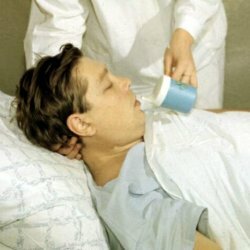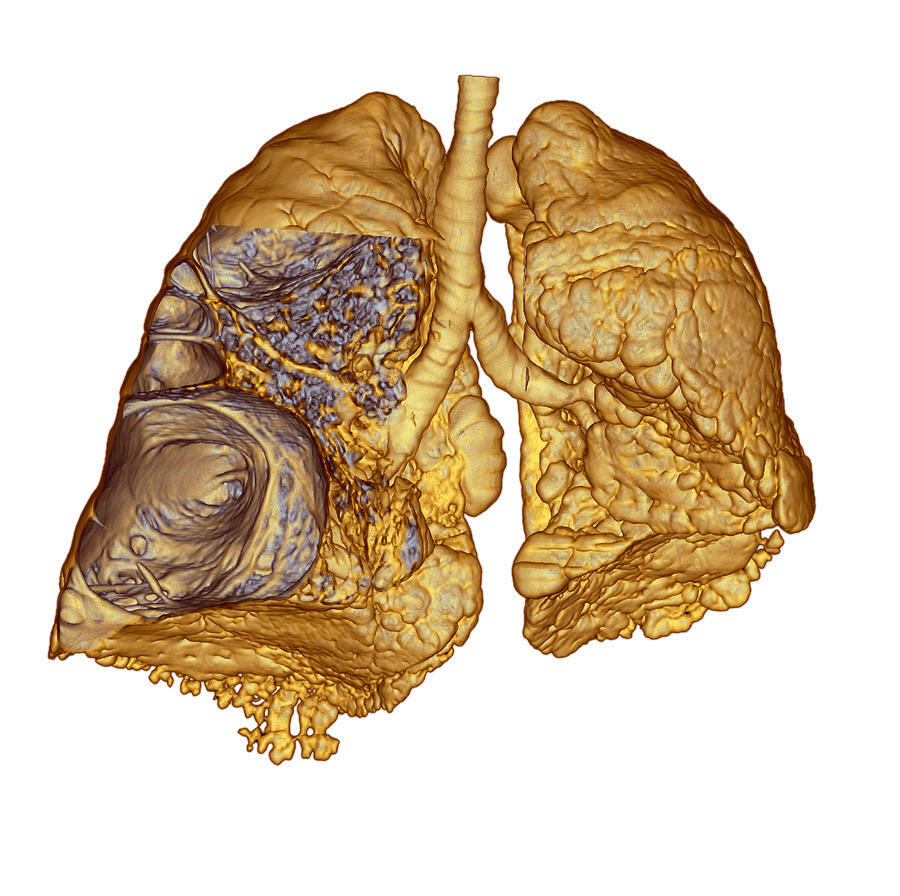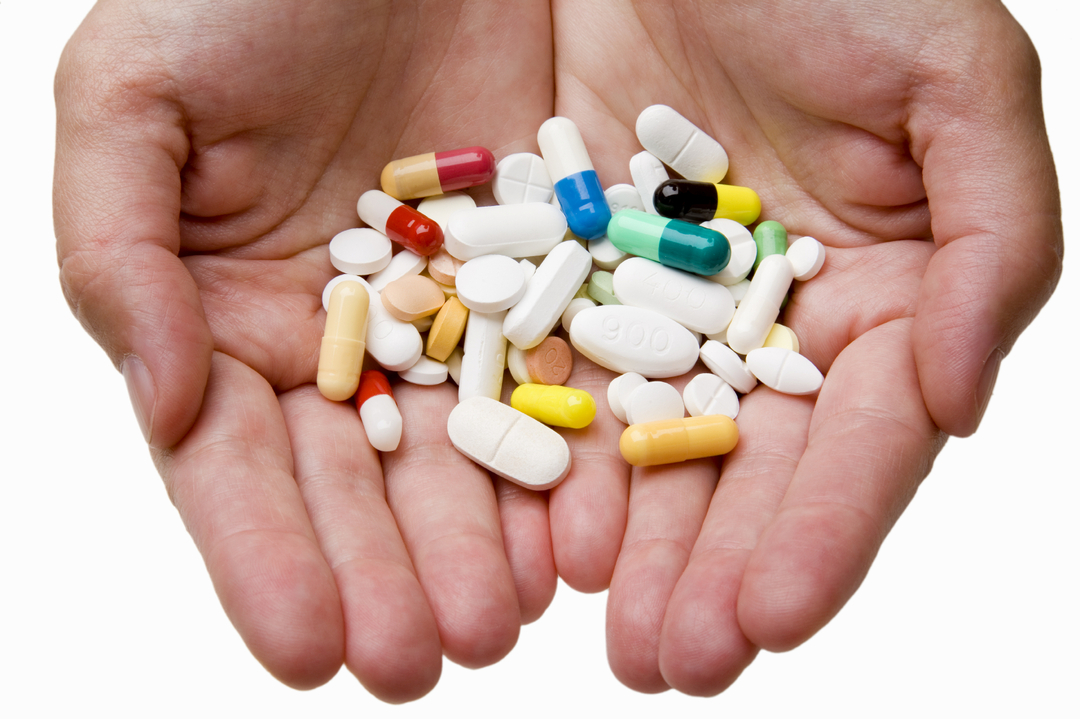Aspiration pneumonia and pneumonitis. Causes, symptoms, diagnosis and treatment

Aspiration pneumonia is of three types:
- mechanical disturbance of the respiratory tract;
- bacterial pneumonia;
- chemical pneumonitis.
Symptoms of aspiration pneumonia and pneumonitis
Main symptoms of diseases:
- wet cough;
- elevated body temperature;
- heart palpitations;
- cyanosis( bluish skin);
- rapid breathing;
- shortness of breath;
- chest pain.
When the disease with chemical pneumonitis after aspiration appears sudden shortness of breath, increases the heart rate, and there are other various symptoms, for example, the patient's body temperature rises, foamy pink sputum appears and cyanosis - a cyanotic skin tone, which is due to the fact thatBlood is poorly supplied with oxygen. Such a disease, like aspiration bacterial pneumonia, begins gradually: first, the body temperature rises, then a wet cough begins, during which sputum with pus leaves, severe pains in the chest begin, wheezing, shortness of breath, tachycardia. During the cough, the pain in the chest becomes stronger. Most often with such a disease, the posterior parts of the upper lobe of the right lung are affected - this is with aspiration in the recumbent position, and the upper segment of the lower lobe - with aspiration in the semi-sitting position of the body. When a foreign body enters the respiratory tract, a painful cough begins. This cough, in the future, may stop, and inflammatory symptoms begin to build up.
main causes of aspiration pneumonia and pneumonitis
Very often tiny food particles are aspirated, ie, get into the respiratory tract, but mainly thanks to the work of normal defense mechanisms they are ejected before you have time to get into the lungs, where these tiny particles can cause inflammationprocess. People who abuse drugs and alcohol are unconscious, under anesthesia( anesthesia), or because of illness, are at greatest risk of contracting this type of pneumonia. Even if a healthy person gets a lot of foreign particles in the respiratory tract, mostly this happens during vomiting, pneumonia may start. One of the most common forms of aspiration pneumonia is bacterial pneumonia. It is caused by bacteria coming from the intestinal tract into the human lungs. As a rule, the causative agents of this disease are aerobic gram-positive cocci( streptococci) and anaerobic bacteria that are in the nasopharynx. Chemical pneumonitis can be affected if the aspirated substance, inhaled by inhalation, is toxic to the lungs. Chemical pneumonitis, to a greater extent, is the result of irritation, and not an infection. This toxic substance can serve as an acid of gastric juice. Also the cause of pneumonia can be and a foreign body, got into the bronchi.
Diagnosis of the disease
Measurement of concentrations of carbon dioxide and oxygen in the blood, as well as chest X-ray, will help to establish a diagnosis, but most often it is obvious after the patient is examined and examined.
Treatment of aspiration pneumonia and pneumonitis
A person ill with the disease, is assigned to a therapy that is directed at the destruction of the main agents of the disease. The patient is given a wide range of antibiotics. In the treatment of chemical pneumonitis, doctors prescribe oxygen, and if necessary, artificial ventilation of the lungs. Often, aspiration from the trachea of mucus and particles trapped in the respiratory tract is also done. To prevent infectious inflammation, some people are sometimes prescribed antibiotics. People with chemical pneumonitis usually recover very quickly, but sometimes there are also cases when developing acute respiratory distress syndrome and bacterial pneumonia. In such cases, 30-50% of patients die. If the cause of pneumonia is some foreign body, it is removed by bronchoscopy. To do this, use fiber-optical medical instruments that allow doctors to consider the patient's airways, take tissue samples for analysis and remove foreign bodies.
An important role in the treatment is also played by nutrition in case of pneumonia. The diet should be easily digestible, but at the same time high-calorie. It is necessary to increase the consumption of fruits and vegetables. During the development of the disease, the human body is prone to dehydration, so it is necessary to monitor the patient's copious drinking. A sick person should take up to 3 liters of fluid per day. Doctors recommend drinking various compotes, milk and juices.
Treatment of the disease with folk remedies
Treatment of aspiration pneumonia and pneumonitis with folk remedies can be carried out only after specialists diagnose the disease and determine its type. Without consulting a doctor, you should never engage in self-medication, as this can lead to very bad consequences.
Garlic is an excellent remedy for fighting pneumonia. Traditional healers are preparing a lot of funds from pneumonia, in which garlic is added.
Several folk recipes that effectively help with pneumonia:
- It is necessary to take 300 gr of garlic and grind it into a gruel. The resulting gruel should be infused for half an hour, for this purpose it is placed in a container and tightly closed with a lid. After the required time, you need to open the container, take from the bottom 200 grams of the juiciest garlic paste and fill it with 1 liter of Cagor wine. This mixture should be infused for 2 weeks. Then the resulting mixture is filtered through gauze, the juice is poured into a glass jar. The tincture can be stored in the refrigerator for a very long time, as it is difficult to guess when it may be needed. It is taken in a hot form. In case of acute illness, take 1 tbsp each hour for tincture. Also, this infusion in a warm form is used for rubbing the chest.
- Here is another very effective prescription for the treatment of pneumonia. It is necessary to take 1 teaspoon of herbs of pine buds, sage leaves, althea root, licorice root and anise fruits( all this is quite affordable and is sold at the pharmacy).Pour the herbal collection 250 ml of boiling water and let it brew for about 20 minutes. Then extract the infusion through the cheesecloth and take every 3 hours for 250 grams, that is, approximately 1 glass of infusion.
- You need to take the following herbal preparations to get 4 teaspoons: fennel, thyme, anise fruits, hoof root, licorice root and pine buds. The resulting herb collection pour 1 cup of water at room temperature. Then let it brew infusion for about 2 hours. After that, it must be brought to a boil, then cooled and filtered through cheesecloth. To use it is necessary within 1 day in 2-3 receptions.
Prevention of the disease
The best preventive treatment for those who are at risk of developing a disease such as pneumonia is vaccine prophylaxis. The risk group includes children, as well as people over 65, people with asthma, smokers, people with diabetes, immunodeficiency and many others. These people must necessarily follow the following preventive measures:
- It is necessary to take vitamin complexes and eat properly, monitor the functioning of your immune system.
- During the period when seasonal diseases begin, a respiratory mask should be worn.
- It is necessary to wash hands thoroughly with soap - this helps to kill pathogenic microorganisms that are on the surface of the body. That is, you need to monitor your personal hygiene.
- You can not allow hypothermia, you need to dress warmly.
It is important to remember that it is easier to prevent the development of aspiration pneumonia and pneumonitis, since treatment can sometimes not save from the complications of these diseases.



